|
101. Euphydryas aurinia (Rottemburg, 1775) / Marsh fritillary / Nymphalidae – Melitaeinae
NL: moerasmelitea, moerasparelmoervlinder / D: Skabiosen-Scheckenfalter, Goldener Scheckenfalter, Grasheiden Scheckenfalter / F: damier de la succise, le damier printanier
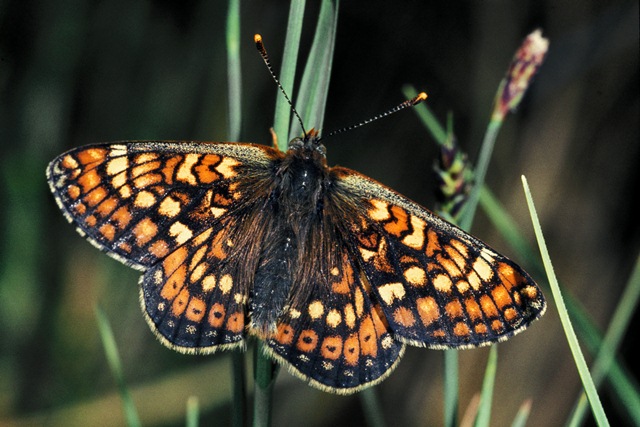 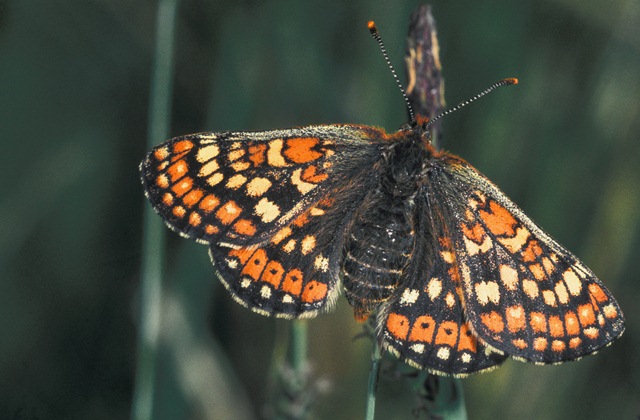 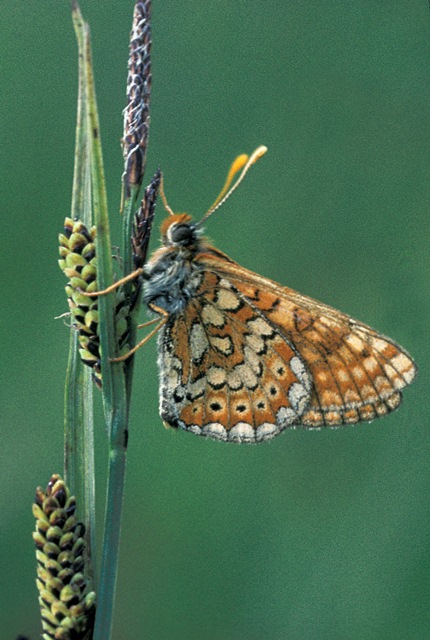
Photographs: Frits Bink ©.
Small or medium-sized, wing length 18 (16-22) mm. Formerly a widely spread species but today it is rare and occurs only locally in Wallonia and Luxemburg. In the Netherlands it was a well-known species characteristic of the ‘blauwgrasland’, a vegetation type of Junco-Molinion, but since 1982 it has disappeared. In Wallonia it occurs in raised bogs along the brooklets where devil’s-bit scabious (Succisa pratensis) is the host as also in dry chalk grass land where it feeds on small scabious (Scabiosa columbaria).
Butterfly is on the wing from early-May until late June. It is known from maritime and continental climates, amplitude 4 to 17. Required heat sum is 700°d and tolerated one 2600°d, corresponding climate windows are 23 and 44 weeks.
The species has been studied extensively in the United Kingdom (Asher et al. 2001: 232-235). In particular its special requirement to maintain stable populations. It became clear that the species only can survive in a metapopulation, a complex of suitable sites, a habitat network, within a distance of less than 15 km.
Although over 80 attempted reintroductions have been documented, all have ultimately failed.
My observation on patrolling behaviour of the males concerns the selectivity of vegetation. The nature reserve where the population occurs, is surrounded by dark green fertilized meadows. The patrolling males soon returned to the unfertilized when flying over a fertilized one.
Breeding experiments have proved that females differ considerably in reproductive capacity; some females lay one clutch of about 600 eggs, whereas others lay less than 300 eggs. The former are so heavily loaded that they can hardly fly but the latter can fly almost as good as males. The thorax of these females is also broader and their abdomen relatively much smaller and thus they are able to migrate.
Ecological characteristics
Behaviour over time
Overwintering: small larva in fourth instar, about 4 mm in length, in a silky nest with at least a hundred larvae together, constructed under wilted leaves of the host-plant near the ground.
Reproduction: oviposition starts after 6-8 days when the body contains 430 (250-600) eggs, potential production the same.
Larval feeding periods: in summer 43 (36-50) days in period end-June until mid-August, in spring 50 (41-60) days from early-March until early-May.
Generations: one.
Spreading of risk: genetically spread within a population, with some individuals able to migrate and others maximising reproduction.
Life cycle: egg 32 (25-38) days; larva 44 weeks; pupa 18 (15-25) days.
Life span of adult: short, 2 weeks.
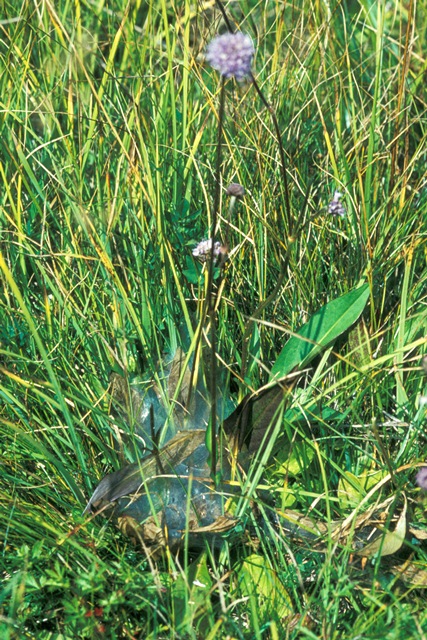 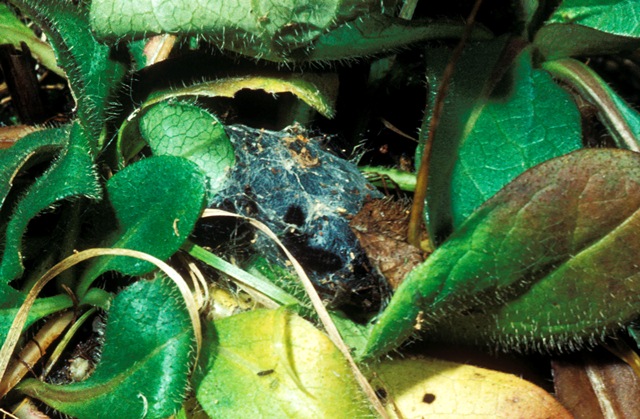 
Photographs: Frits Bink ©.
Behaviour in space
From stay-at-home to migrant: stay-at-home, spatial requirement modest.
Finding a mate: male patrols and explores the surroundings widely.
Orientation in the landscape: on medium tall grass vegetation in an open landscape.
Oviposition: one big clutch of a compact mass of eggs on the underside of a leaf of the hostplant, sometimes followed by a second smaller one elsewhere.
Defence
Threats from other organisms: the black colour and the covering with bristles give the larvae some protection to avian predation, but they are not safe from birds like magpie (Pica pica).
Threats from the environment: the adults are sensitive to cold weather.
Feeding habits
Adult: nectar, but the need for food is very small, it is just heat that is required.
Larva: in summer, when young it feeds collectively on the mesenchyme from the underside of the leaf, in spring they clump together to get warmth from the sun, later they swarm around and feed only for a while on a host-plant.
Larval foodplants
Plant species: Dipsacaceae, Scabiosa columbaria, Succisa pratensis.
Journal
Rearing experiments based on specimens from Ditchling, Sussex, England:
First.
15 April 1983: 100 larvae received, feeding on honeysuckle.
16 April: 50 larvae released into reserve Meeuwenkampje. (see below), remainder kept indoors.
Indoor brood:
24 April: three pupated, one fully grown larva seen at the reserve.
15 May: first adult appeared, male.
23 May: first female appeared.
3 June: female died, body contains 164 eggs.
Second.
24 June 1983: batch of eggs received, some already hatched.
3 July: newly born larvae feed in array together on the underside of the leaf.
19 July: larvae in third instar, made a big web and basked when sun shined.
30 July: all larvae in diapause in the fourth instar.
25 September: larvae had made new nest, under the leaf of Succisa near to the soil.
Overwintered outdoors.
23 February 1984: larvae basked as soon there was sun, together they form a big black spot on the nest.
29 February: larvae started to eat.
15 March: about 10% of the larvae already moulted.
17 March: ten larvae in last instar.
31 March: nearly all larvae in last instar.
22 April: most pupated.
8 May: first adult appeared.
10 May: nine males hatched.
11 May: two females.
13 May: all pupae hatched.
16 May: one pairing observed.
19 May: five pairings observed, temperature 36°C, butterflies very active.
26 May: three butterflies oviposited when room temperature reached 25°C.
13 June: eggs reddish in colour.
18 July: larvae in second instar, they had made a new nest.
17 August: larvae in fourth instar, probably all in diapause.
Overwintered outdoors.
2 February 1985: larvae became active when temperature exceeded 10°C.
24 February: larvae basked on first day after a period of frost.
11 May: larvae nearly fully grown.
19 May: no larvae seen (all pupated?)
Results of the introduction trial at the reserve Meeuwenkampje, Veenendaal, Netherlands:
The intention was to test the influence of the management of hay making.
16 April 1983: 250 larvae released in reserve at five spots marked with sticks.
24 April: one fully grown larva seen.
Overwintered in the field.
8 March1984: visited the reserve, five nests inspected, all together 138 larvae found, that means 45 % mortality during overwintering on marked spots which were safely spared at the time of hay making.
17 April: reserve surveyed: 25 larvae seen, one in last instar. Temperature at noon, measured at the different spots, ranged from 20.8°C up to 34.0°C. At 34°C the larvae were searching for shaded places.
At the releasing spots the density of hostplants was 3.13 up to tenfold, 9 plants per square meter on the average. No difference in survival rate to hostplant density could be observed.
Further input of larvae into the reserve Meeuwenkampje:
30 July 1984: three batches of 150 larvae in second instar released into unmarked spots, so not excluded at the time of hay making.
31 May 1985: one female and two males seen.
7 May 1986: no larvae seen.
27 May: no butterflies seen.
Additional information: hay making in autumn 1985 was performed by a powerful machine and all larvae nests were destroyed.
Rearing experiment based on specimens from Montmédy, France:
12 June 1984: two batches of eggs collected from Scabiosa columbaria on a chalk grassland.
25 June: older egg batch hatched.
28 June: second batch hatched.
18 July: larvae second instar, had made a new nest.
17 August: larvae had spun another new nest, probably in diapause.
Overwintered indoors.
15 March 1985: larvae started feeding.
26 March: one larva moulted, now last instar. The last but one instar takes only 4-5 days.
31 March: two larvae nearly fully grown, accepted Succisa pratensis as food very well.
10 April: first prepupa.
15 April: three large pupae found.
20 April: two larvae, remainder pupated.
28 April: last larva pupated.
11 May: third female hatched.
16 May: fourth female hatched.
19 May: last pupa hatched.
Table 101-1. Results of dissections

Table 101-2. Collection and observation localities
B, Baraque de Fraiture, 550 m, 50° 14’ 32”N – 5° 46’ 58”E; 15,June 1980, 19 June 1983, 6 May 2000 (larvae).
B, Virton, 230 m, 49° 35’ 05”N – 5° 33’ 19”E; 15 June 1980, 19 June 1983.
D, Staffelstein 50° 05’ 32”N – 11° 01’ 25”E; 16 June 1985.
F, la Garde Freinet, 100 m, 43° 19’N – 6° 30’E; 29 April 1997.
F, Montmédy, 217 m, 49° 31’ 07”N – 5° 21’ 33” E; 12 June 1984.
NL, Zegveld, 52° 08’ 09”N – 4° 48’ 56”E; 10 June 1956 (many worn adults), 21 May 1959 (about 2000 adults), 24 April 1975 (a few larvae), 5 June 1975 (two adults), 11 June 1975 (49 adults).
S, Gotland, Stygmyr, 57° 50’ 01”N – 18° 38’ 21”E; 26 June 1991, 18 July 2004.
S, Gotland, Bälsavret, 57° 39’ 38”N – 18° 40’ 51”E; 5 July 2004.
Fig. 101-1. Euphydryas aurinia, phenogram adapted from Fichefet et al. 2008: 211.
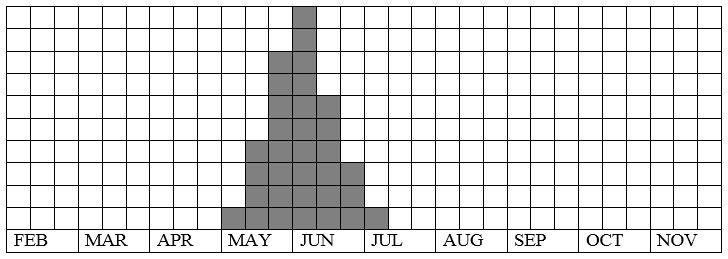
Fig. 101-2. Euphydryas aurinia, habitat characteristics.
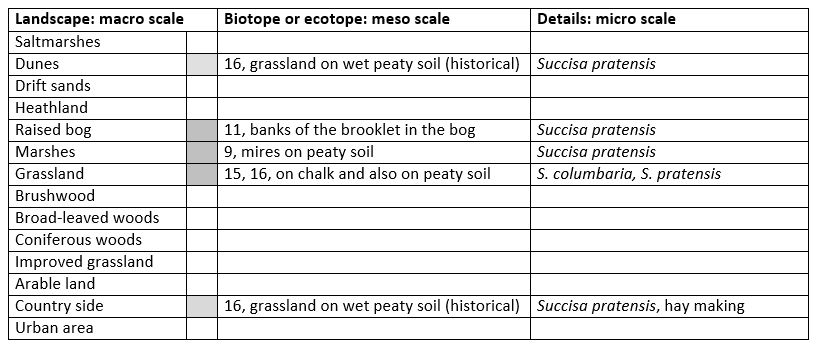
Fig. 101-3. Euphydryas aurinia, climate matrix, heat-sums 700 - 2600°d.
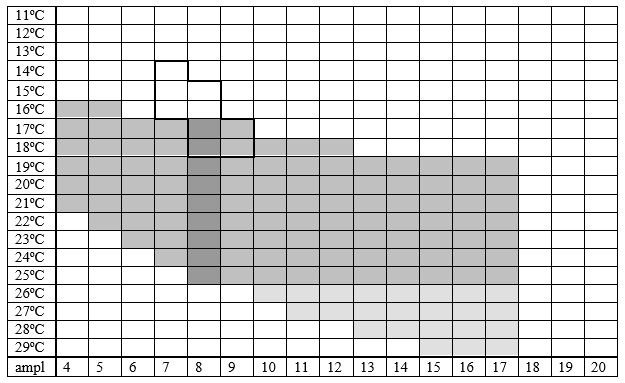
|











